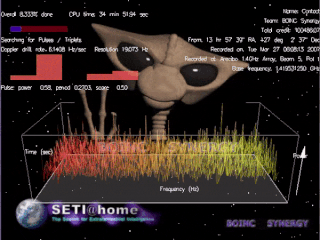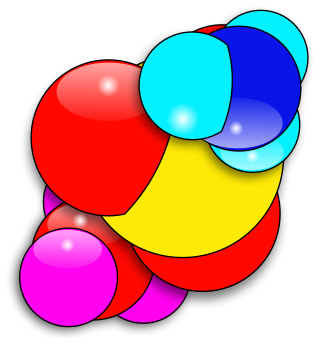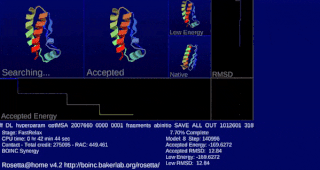Related Research Articles

Protein tertiary structure is the three dimensional shape of a protein. The tertiary structure will have a single polypeptide chain "backbone" with one or more protein secondary structures, the protein domains. Amino acid side chains may interact and bond in a number of ways. The interactions and bonds of side chains within a particular protein determine its tertiary structure. The protein tertiary structure is defined by its atomic coordinates. These coordinates may refer either to a protein domain or to the entire tertiary structure. A number of tertiary structures may fold into a quaternary structure.
Grid computing is the use of widely distributed computer resources to reach a common goal. A computing grid can be thought of as a distributed system with non-interactive workloads that involve many files. Grid computing is distinguished from conventional high-performance computing systems such as cluster computing in that grid computers have each node set to perform a different task/application. Grid computers also tend to be more heterogeneous and geographically dispersed than cluster computers. Although a single grid can be dedicated to a particular application, commonly a grid is used for a variety of purposes. Grids are often constructed with general-purpose grid middleware software libraries. Grid sizes can be quite large.
GROMACS is a molecular dynamics package mainly designed for simulations of proteins, lipids, and nucleic acids. It was originally developed in the Biophysical Chemistry department of University of Groningen, and is now maintained by contributors in universities and research centers worldwide. GROMACS is one of the fastest and most popular software packages available, and can run on central processing units (CPUs) and graphics processing units (GPUs). It is free, open-source software released under the GNU General Public License (GPL), and starting with version 4.6, the GNU Lesser General Public License (LGPL).

SETI@home is a project of the Berkeley SETI Research Center to analyze radio signals, searching for signs of extraterrestrial intelligence. Until March 2020, it was run as an Internet-based public volunteer computing project that employed the BOINC software platform. It is hosted by the Space Sciences Laboratory at the University of California, Berkeley, and is one of many activities undertaken as part of the worldwide SETI effort.

Folding@home is a volunteer computing project aimed to help scientists develop new therapeutics for a variety of diseases by the means of simulating protein dynamics. This includes the process of protein folding and the movements of proteins, and is reliant on simulations run on volunteers' personal computers. Folding@home is currently based at the University of Pennsylvania and led by Greg Bowman, a former student of Vijay Pande.
Genome@home was a volunteer computing project run by Stefan Larson of Stanford University, and a sister project to Folding@home. Its goal was protein design and its applications, which had implications in many fields including medicine. Genome@home was run by the Pande Lab.
grid.org was a website and online community established in 2001 for cluster computing and grid computing software users. For six years it operated several different volunteer computing projects that allowed members to donate their spare computer cycles to worthwhile causes. In 2007, it became a community for open source cluster and grid computing software. After around 2010 it redirected to other sites.

Vijay Satyanand Pande is a Trinidadian-American venture capitalist. Pande is the former director of the biophysics program and is best known for orchestrating the distributed computing disease research project known as Folding@home. His research is focused on distributed computing and computer-modelling of microbiology. His research focuses on improving computer simulations regarding drug-binding, protein design, and synthetic bio-mimetic polymers. Pande became the ninth general partner at venture capital firm Andreessen Horowitz in November 2015.

Predictor@home was a volunteer computing project that used BOINC software to predict protein structure from protein sequence in the context of the 6th biannual CASP, or Critical Assessment of Techniques for Protein Structure Prediction. A major goal of the project was the testing and evaluating of new algorithms to predict both known and unknown protein structures.

World Community Grid (WCG) is an effort to create the world's largest volunteer computing platform to tackle scientific research that benefits humanity. Launched on November 16, 2004, with proprietary Grid MP client from United Devices and adding support for Berkeley Open Infrastructure for Network Computing (BOINC) in 2005, World Community Grid eventually discontinued the Grid MP client and consolidated on the BOINC platform in 2008. In September 2021, it was announced that IBM transferred ownership to the Krembil Research Institute of University Health Network in Toronto, Ontario.

The Human Proteome Folding Project (HPF) is a collaborative effort between New York University, the Institute for Systems Biology (ISB) and the University of Washington, using the Rosetta software developed by the Rosetta Commons.

Rosetta@home is a volunteer computing project researching protein structure prediction on the Berkeley Open Infrastructure for Network Computing (BOINC) platform, run by the Baker laboratory at the University of Washington. Rosetta@home aims to predict protein–protein docking and design new proteins with the help of about fifty-five thousand active volunteered computers processing at over 487,946 GigaFLOPS on average as of September 19, 2020. Foldit, a Rosetta@home videogame, aims to reach these goals with a crowdsourcing approach. Though much of the project is oriented toward basic research to improve the accuracy and robustness of proteomics methods, Rosetta@home also does applied research on malaria, Alzheimer's disease, and other pathologies.
Similarity Matrix of Proteins (SIMAP) is a database of protein similarities created using volunteer computing. It is freely accessible for scientific purposes. SIMAP uses the FASTA algorithm to precalculate protein similarity, while another application uses hidden Markov models to search for protein domains. SIMAP is a joint project of the Technical University of Munich, the Helmholtz Zentrum München, and the University of Vienna.

Volunteer computing is a type of distributed computing in which people donate their computers' unused resources to a research-oriented project, and sometimes in exchange for credit points. The fundamental idea behind it is that a modern desktop computer is sufficiently powerful to perform billions of operations a second, but for most users only between 10-15% of its capacity is used. Typical uses like basic word processing or web browsing leave the computer mostly idle.
AMD FireStream was AMD's brand name for their Radeon-based product line targeting stream processing and/or GPGPU in supercomputers. Originally developed by ATI Technologies around the Radeon X1900 XTX in 2006, the product line was previously branded as both ATI FireSTREAM and AMD Stream Processor. The AMD FireStream can also be used as a floating-point co-processor for offloading CPU calculations, which is part of the Torrenza initiative. The FireStream line has been discontinued since 2012, when GPGPU workloads were entirely folded into the AMD FirePro line.
Storage@home was a distributed data store project designed to store massive amounts of scientific data across a large number of volunteer machines. The project was developed by some of the Folding@home team at Stanford University, from about 2007 through 2011.

A PlayStation 3 cluster is a distributed system computer composed primarily of PlayStation 3 video game consoles.

Life with PlayStation was an online multimedia application for the PlayStation 3 video game console on the PlayStation Network. The application had four channels, all of which revolved around a virtual globe that displayed information according to the channel. The application also included a client for Folding@home, a distributed computing project aimed at disease research. As of November 2012 the service has been discontinued.
GridRepublic is a BOINC Account Manager. It focuses on creating a clean and simple way to join and interact with BOINC. GridRepublic was started with a mission to raise public awareness and participation in volunteer computing with BOINC. GridRepublic was formed in 2004 by Matthew Blumberg as a mechanism to control the multiple projects from one place. The code for the BOINC software had to be redesigned to allow for the Account Manager system to be implemented.
References
- ↑ "USPTO registration number 2734759". US Patent and Trademark Office. July 8, 2003.
- ↑ "CTM 011483286". European Union Intellectual Property Office. May 27, 2013.
- ↑ "distributed.net History & Timeline". distributed.net.
- ↑ "distributed.net Articles of Incorporation". distributed.net. July 2, 1997. Retrieved October 28, 2016.
- ↑ David McNett (April 23, 1999). "A look towards the future". Distributed.net mailing list. Archived from the original on October 3, 1999. Retrieved October 28, 2016.
- ↑ "Innovators Under 35: Adam Beberg, 25", MIT Technology Review, 1999, retrieved October 28, 2016
- ↑ "Folding@home - About". Folding@home. Stanford University. Archived from the original on April 25, 2013. Retrieved October 3, 2022.
- ↑ Jesse Victors (November 10, 2011). "Six Native PetaFLOPS". Folding@home. phpBB Group. Retrieved June 3, 2012.
- ↑ "Stanford University: Protein Researchers Bring Mac Users into the Fold". Apple. February 2002. Archived from the original on April 4, 2004. Retrieved October 28, 2016.
- ↑ "Adam L. Beberg". Researcher page. Stanford University Computer Science Department. Retrieved October 28, 2016.